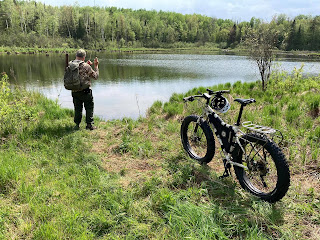 |
| QBP Photo |
The Cogburn drew its name from the tough, fearless one-eyed US Marshal Ruben J. “Rooster” Cogburn played by John Wayne, Jeff Bridges, and Warren Oates in the three variations of Charles Portis’ Western novel, “True Grit.” Cogburn brand manager Bobby Dahlberg said that the name was meant to evoke the spirit of Rooster Cogburn, “a rough-and-tumble guy who gets it done.” Quality’s own advertising for the brand called the bike, “a human powered all-terrain vehicle (ATV) built to take hunters, anglers and foragers quickly and quietly further into the backcountry.” They introduced the brand at Minnesota’s Game Fair, promoting its backcountry capability with T-shirts emblazoned with a deer head and gear cog motif, and the insignia of Backcountry Hunters and Anglers (BHA) on the sleeve, the sale of which generated a two-dollar donation to BHA for every shirt sold.
 |
| QBP Photo |
The volunteer mountain bike patrol that I
belonged to (and still do) had been gifted two Surely Pugsleys, so I was
familiar with fat-bikes. I had seen the Cogburn at Game Fair, bought one of the
T-shirts and camo ball cap with the logo embroidered on it, (I still have both)
but it wasn’t until the Winter Camping Symposium the following October that I
was actually able to ride one. It was “love at first ride.” With its upright
seating position and longer wheelbase, the Cogburn was a joy to ride. I’ve said
elsewhere in this blog that two years earlier I had purchased a custom-built
mountain bike, and it’s a great bike built for the rigors of bike patrol and
emergency medical services. But, if the Cogburn had been introduced two years
earlier, I probably never would have bought the patrol bike. I ordered one
shortly after arriving home from the symposium, and took delivery at the end of
December, just after Christmas.
It’s been said more than once that I put the “angler” into Backcountry Hunters and Anglers, the national public lands and waters advocacy organization that I had been part of for several years before the Cogburn came out. Indeed, initially my bike was used to access backcountry streams and lakes, but it was such a great ride that it quickly became my primary mountain bike. Although I have great fellow feelings for both gun and archery hunting, I am not a hunter. I use the Cogburn to seek trout.
There were some very good magazine articles,
videos, and even some syndicated TV programs that featured the Cogburn in its
native environment. Publications as diverse as “Petersons Hunting,” “Wheels Afield,”
“Bicycling,” and “Outside” featured stories about the Cogburn. The bikes
appeared on several different episodes of "My Outdoor TV" streaming service. Word
got out, and sports men and women responded positively.
Sadly, the Cogburn’s run lasted only a few
years. In October of 2017, just four years after it was introduced, QBP
announced on social media that they were shutting down the Cogburn program, thanking those of
us who had bought the bikes for our support and wishing us the best. While it
was never revealed the exact cause for the shutdown, marketing pressures being
what they are, what had been a unique niche had attracted competitors, and many
of those utilized pedal-assist electric motors. Where the Cogburn could get you
farther, faster, and with minimum impact, E-bikes did the same thing, expended
less human energy, and came in a variety of camouflage paint jobs.
Wishing you dry trails and tight lines.

